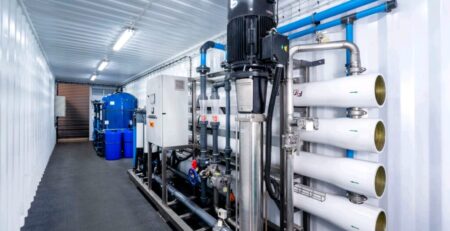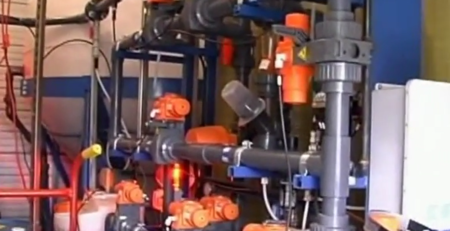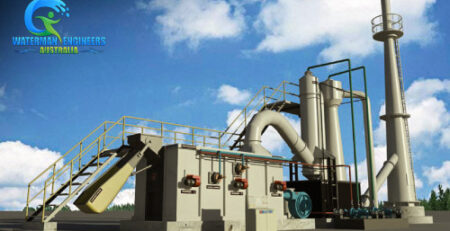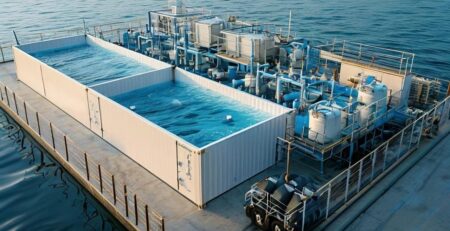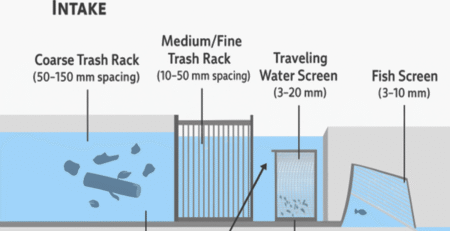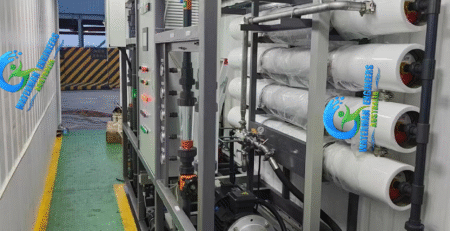How & Why Desalination Plants on Rent Are Beneficial for Short-Term or Mobile Mining Operations
How & Why Desalination Plants on Rent Are Beneficial for Short-Term or Mobile Mining Operations
FOR AUSTRALIAN CLIENTS ONLY
Mining operations often face unpredictable water supply challenges, especially when sites are temporary, have short lifespans (1–2 years), or shift locations frequently. In these scenarios, renting a modular desalination plant provides critical benefits that permanent infrastructure simply cannot match.
Solves Remote and Saline Water Supply Challenges
Many mining sites are located in remote regions where local surface water is scarce, seasonal, or unsuitable due to high salinity. Rented desalination plants — typically using Reverse Osmosis (RO) — can treat brackish groundwater, saline aquifers, or seawater to produce high-quality water for:
● Ore processing (e.g., flotation, leaching)
● Dust suppression on haul roads
● Equipment cooling and washing
● Drinking water for camps and offices
● Environmental discharge blending
With rental, miners gain immediate access to clean water without long waits for permanent infrastructure.
2️⃣ Fast Deployment for Tight Schedules
Temporary or mobile mining operations need infrastructure that matches their speed. Containerised desalination plants on hire are:
✅ Fully pre-assembled, tested, and ready to ship
✅ Delivered in standard 20 ft or 40 ft containers
✅ Installed and commissioned in days or weeks — not months
This rapid mobilization keeps mining projects on schedule, avoiding costly production delays due to water shortages.
3️⃣ Zero Stranded Capital
Building a permanent desalination plant for a site that may close in 12–24 months is risky and often uneconomical. Renting a mobile desal plant converts capital expenditure (CAPEX) into operational expenditure (OPEX). This means:
No large upfront capital lock-in.
● Flexible rental terms aligned with the mine’s actual operating window.
● The equipment can be returned or relocated when the site is exhausted.
This protects cash flow and frees capital for core mining activities.
4️⃣ Easily Relocated to Follow Mining Progress
As mining expands to new pits or satellite deposits, the same desalination unit can be relocated:
✅ Containerised units can be moved by truck or barge.
✅ Minimal disassembly required — plug-and-play connections simplify redeployment.
✅ No permanent site works are abandoned when the unit moves.
This mobility is ideal for exploration sites, seasonal satellite mines, or pilot extraction projects.
5️⃣ Supports Compliance and Environmental Stewardship
Temporary sites still face strict water regulations. Desalination on rent helps operators:
● Avoid drawing down limited freshwater from local communities or sensitive ecosystems.
● Achieve discharge limits for salinity or total dissolved solids (TDS).
● Enable water reuse within the site to minimise waste.
For coastal mining operations, rented seawater RO plants allow sustainable supply without over-reliance on groundwater bores.
6️⃣ Compact, Modular & Low-Footprint
Rented desalination systems are designed for remote sites:
● Fully containerised with integrated pre-treatment (UF or multimedia filters), dosing systems, RO skids, and CIP units.
● Occupy a small footprint — ideal for constrained camp or pit locations.
● Robust housing protects the equipment in harsh climates.
No need for large buildings or permanent plant rooms — saving space and civil costs.
7️⃣ Professional Support Included
Rental contracts often include:
✅ Regular maintenance and membrane cleaning
✅ Performance guarantees
✅ Spare parts and emergency backup
✅ Remote monitoring and technical support
This ensures maximum uptime with minimal in-house expertise needed, which is especially valuable at remote or temporary sites with limited technical staff.
Renting containerised desalination plants provides mining operators with a fast, flexible, low-risk way to secure high-quality water — exactly when and where it’s needed — without tying up capital in infrastructure that may outlast the site’s life.
This approach supports safe, sustainable operations for short-term or mobile mining projects, while protecting budgets and minimising environmental impacts.
Example Typical Rented Desal Plant:
Parameter |
Typical Range |
Capacity |
50–2,000 m³/day |
Feed Source |
Brackish groundwater, seawater |
Housing |
20–40 ft container |
Components |
UF pretreatment, RO, dosing, CIP skid |
Deployment |
4–8 weeks typical |
Relocation |
Truck or barge, plug-and-play |
Power |
Local grid or onsite generator |
Conclusion
Desalination plants on rent are a practical, proven solution for short-lived or mobile mining operations that demand flexibility, fast deployment, cost control, and environmental responsibility — all critical for modern mining success.
1️⃣ Why Mining Sites May Need Desalination
Mining sites — even for short durations — often face serious water challenges:
- Many sites are in arid or remote regions with little or no fresh water sources nearby.
- Mines may rely on poor-quality groundwater or brackish aquifers that exceed salinity levels for use in process plants, dust suppression, or camp supply.
- Local surface water may be seasonal or insufficient for continuous operations.
- Regulatory and community pressures often prohibit excessive freshwater extraction from local rivers or aquifers.
A desalination plant makes it possible to convert saline or brackish water into high-quality process or potable water, supporting:
- Ore processing (e.g., flotation, leaching, washing)
- Dust control
- Equipment cooling
- Potable water for camps and offices
- Environmental flow offsets or discharge compliance
2️⃣ Why Desalination Is Still Relevant for Short-Term or Mobile Sites
While a permanent, large-scale desalination plant may not make sense for a short mine life, modular or containerised desalination plants on hire offer practical, cost-effective solutions because they are:
✅ Mobile and Relocatable
- Plants can be containerised and skid-mounted.
- When a pit is exhausted or the mine moves to a satellite deposit, the plant is lifted, trucked, and redeployed to the next site.
- No need for sunk civil infrastructure — the investment moves with the operation.
✅ Fast to Deploy and Demobilise
- Modular RO (reverse osmosis) units can be on site and running within weeks.
- When mining stops, the plant is removed just as quickly, with minimal decommissioning work.
- This speed aligns with short mining windows or exploration campaigns.
✅ Flexible Sizing
- Desal units can be upsized or downsized by adding/removing modules to match changing water demands.
- This prevents over-investment in capacity that may sit idle if production drops.
✅ Lower CAPEX Risk
- Many mining companies hire desal plants instead of buying them for short-term projects.
- This converts big capital costs into an operational expense, preserving cash for the core mining business.
✅ Compliance Made Easy
- Short-term mines still face strict regulations for discharge salinity, chemical residues, and freshwater use.
- Desalination helps sites meet water discharge standards by enabling reuse and avoiding brine contamination of local waterways.
3️⃣ How Modular Desalination Systems Work for Mobile Mining
A typical mobile desalination plant for mining:
- Uses brackish water reverse osmosis (BWRO) or seawater RO (SWRO) membranes, depending on feed salinity.
- Includes pre-treatment skids (UF or multimedia filters) inside the same container.
- Has built-in chemical dosing (anti-scalant, pH adjustment) and CIP skids.
- Comes fully containerised for plug-and-play operation.
- Uses standard shipping containers — easy to transport by truck or barge to remote or coastal sites.
- Often designed for harsh climates with corrosion-resistant materials and robust housings.
4️⃣ Typical Use Cases for Short-Term or Mobile Mining
Example Scenarios:
- Coastal Mineral Sands: Extracting minerals near the coast where seawater desalination is ideal for processing and potable water.
- Remote Copper or Gold Exploration: Short-term camps using brackish boreholes that need RO to meet potable standards.
- Temporary Tailings Remediation: Treating saline groundwater inflows while tailings are stabilised.
- Satellite Pits: Small deposits far from the main site where a permanent water supply is uneconomic.
5️⃣ Environmental & Community Advantages
Desalination reduces reliance on scarce local freshwater sources, helping secure local community support.
- It enables mining companies to maintain water supply without trucking in vast volumes of water — reducing carbon footprint and haulage costs.
- Brine management can be controlled with modern zero-liquid discharge (ZLD) add-ons if needed for sensitive sites.
✅ Key Takeaway
A modular, containerised desalination plant — hired or leased — gives mining operators the freedom to manage variable, short-term, or remote water supply needs with:
- Minimal upfront cost
- Rapid deployment
- Flexibility to relocate as pits open or close
- Scalability to match changing flows
- Compliance with discharge and reuse standards
For mines operating on tight schedules and shifting sites, this mobility minimises stranded capital, ensures continuous supply, and strengthens environmental stewardship.
Example: Typical Mobile Desalination Plant on Hire
| Feature | Typical Spec |
| Capacity | 50–2,000 m³/day |
| Feed Source | Seawater or brackish boreholes |
| Recovery | 50–70% depending on salinity |
| Container Size | 20 or 40 ft |
| Pre-treatment | UF / multimedia filter |
| Post-treatment | Remineralisation if for potable use |
| Power Supply | Diesel gen-sets or grid |
| Transport | Truck or barge |
Final Point
Even for short-lived projects, the right mobile desal plant can be the difference between:
- Paying millions to truck in water,
- Delaying production due to water shortages,
- Or violating local environmental limits.


